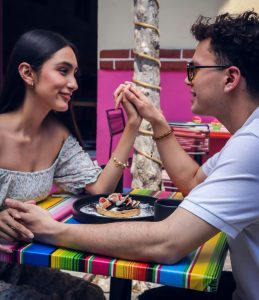4.3 Dein Freund oder ein Freund von dir?

Guten Tag!
Zum Aufwärmen machen wir unseren Tagesminiplausch und eine Wiederholung.
Wiederholung
In the previous lesson, you learned how to introduce your best friend, say where they live, and how old they are. Let’s review what you have learned.
Read and listen to Yasmin’s description of her best friend. Then, practice reading the description aloud yourself.
 |
Mein bester Freund heißt Timo. Er ist 23 Jahre alt und studiert Literatur. Er wohnt in München. Er ist klein und hat blonde Haare. Seine Augen sind braun. Timo ist sehr intelligent. Ich finde Timo auch sympathisch und freundlich. |
Read Yasmin’s description aloud one more time in your audio journal. How does it feel to be able to read German aloud and to understand what it means?
Lektionsüberblick
Whom we called friend is often culturally based. Compared to German, there are fewer words in English for “people we know and like but maybe do not hang out and we would not call in an emergency”. Germans generally reserve the words “Freund/Freundin” for close friends and then use a variety of words – to be covered in this lesson – to describe the kind of person mentioned previously. To make matters more complicated is that the words “Freund/Freundin” are also the words for boyfriend/girlfriend, i.e. they suggest a romantic relationship. In this lesson, we will look at some of the words used in German to talk about people we like (and people we “like” like). In the end, you will be able to 1) use the language of friendship and 2) use the language of romantic relationships.
1) How to talk about friends
Look at the examples and see if you can guess what level of friendship the individuals have with one another.
 |
 |
| Sie sind Schulkameraden. | Sie sind gute Freunde. Sie sind Kumpels. |
 |
 |
| Er ist ein neuer Bekannter. | Die Frau sagt, “Er ist ein Friend von mir.” |
Also remember that you can describe someone as your best friend. You can review that in the Wiederholung above, if needed.
Using the clues in the images and statements above, practice with the following questions. Be sure to click through to each question.
🎥 For fun, you can watch this video in which native Germans describe their friendships and what friendship means to them.
Jetzt bist du dran!
Frankfurt am Main in Blickpunkt

Das Gebäude The Squaire steht über dem Fernbahnhof am Flughafen Frankfurt. Es ist 660 Meter lang und sieht ein bisschen aus wie ein gestrandeter Wal. The Squaire gilt als das größte Bürogebäude Deutschlands.
The Squaire building stands above the long-distance train station at Frankfurt Airport. It’s 660 meters long and looks a bit like a beached whale. The Squaire is the largest office building in Germany.
2) How to talk about romantic relationships
Can you tell which statements have to do with being self-partnered versus being in a party of two?
 |
Ich bin ledig. Ich bin single. |
| Wir haben ein Date. Wir verabreden uns. |
 |
 |
Wir sind in einer festen Beziehung. |
Using the clues from above, practice with these questions. Be sure to click through to each question.
Jetzt bist du dran!
Zum Schluß

*As you conclude this lesson, don’t forget to check Canvas!*

Media Attributions
- 1010-1020 banner long large reduced
- Image of Yasmin from Grenzenlos Deutsch, GD Yasmin-223×300, licensed under a Creative Commons Attribution-NonCommercial-ShareAlike 4.0 International License. © Grenzenlos Deutsch is licensed under a CC BY-NC-SA (Attribution NonCommercial ShareAlike) license
- Picture of school children bypexels-panditwiguna-3401403
- Photo of friends by pexels-bertellifotografia-3856031
- Photo of woman shaking hands bypexels-ron-lach-8921545
- Photo of friends looking at devices by pexels-william-fortunato-6140707
- Photo of The Squaire, Frankfurt am Main by
- Photo of woman with flower by pexels-mihmanduganli-19793325
- Photo of couple on date by pexels-vanessa-pozos-3368660-24018220
- Photo of older couple by pexels-rdne-5637731
- Private: confidence scale_large horizontal_updated

